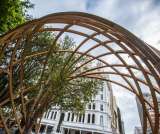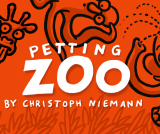
“Creativity is a small defiant act of misbehaving,” announced graphic designer Paula Scher in the opening presentation of the 16th international Design Indaba Conference yesterday morning. And with that small quotable quote, the titan of American design set the tone for a rather mischievous day full of unpredictable design solutions, MCed by the perennially dry Michael Bierut, Twitter darling Khaya Dlanga and bombshell-with-brains Michelle Constant.
Architectural and geographic typography
A partner at Pentagram design Paula showed a striking portfolio of her unique brand of “graphic design”, which she has termed environmental graphics. See, the bold typography and striking colours hardly ever sit on a page: she designs it for installation in architectural spaces and can turn the dullest school gym into a richly layered visual treat. On the side, her weekend art hobby so to speak, is to apply her typography to maps.
Hell, war, art, bras and shoes
The second speaker was Paula’s incorrigible octogenarian husband, Seymour Chwast whose imagination is wild and wit is wicked. His drawings and posters had the audience in stitches – from the satirical “War is good business, invest your son” and “High rise hell” showing a contemporary inverted revision of Dante (with the last level filled with spammers) to the delightful “Kama Sutra of Reading” and ridiculous book of bra fashions. Not to mention his shoe fetish (with lots of toe cleavage). Quotable quote: “I steal material sometimes, but only when it's appropriate. I have my integrity.”
Government design
One of the Design Indaba survival tips is: never miss the speakers you haven’t heard of. Not only had none of us heard of Ben Terrett but his description as head of design for the UK government (as in he works at 10 Downing Street) sounded like a snooze cruise – and it could have been. But with such humility and insight he described one of the biggest information architecture and design projects ever: Taking 400 UK government websites and simplifying into one, gov.uk, with simple interface and easy enough for everyone to understand and find the information they are looking for.
The need for that in South Africa was evident by the number of appreciative tweets during his presentation. He also spoke extensively about the help he got from Margaret Calvert, the designer behind the UK road sign system that has become adopted almost all over the world. VISI magazine kindly pointed out to him that Margaret is South African.
The sound of a scribble
Next up, Alexander Chen, a creative director at Google, had everyone in the auditorium’s mouth hanging open in a stupor as he showed how he turned simple lines into pluckable guitar strings. His famous Les Pauls Google doodle is but one project, as he also showed his Bach machineand subway map instrument. The real showstopper however was the Google Glasses project in which he showed just how close we are to a science-fiction Minority-Report-type reality.
Visualising time
You know those people that just can’t help being what they are, that are in design mind 24-7 Oscar Diaz, a Spanish designer who studied and works in London, is one of those. Although his ink-absorption calendar is beautiful, we at VISI were particularly blown away by his pound-shop hacks in which he redesigned 10 products typically found in pound-shops. Probably we liked it so much because it speaks to the sensibility of proactive DIY that is in our DIY Deluxe edition. His RGB vase, which used red, green and blue glass over each other to create yellow, also made us sit up straight.
Student freedom
Another highlight on the conference programme is always the student pecha kuchas. Perhaps it’s the freedom from commercial restraints that gives the student projects an extra sense of wow. This year Howard Chambers and Bland Hoke's Softwalks project that added seats, tables and plants to city scaffolding; the gestural interactive digital sound instruments of Pieter-Jan Pieters; and the resuscitated prehistoric mammoths by Marguerite Humeau particularly stood out for us. And of course, our favourite, Leanie van der Vyver, born and raised in Paarl who created an internet sensation last year with her Scary Beautiful shoes – she is also featured in our DIY Deluxe edition.
The real gets more respect
Probably the most entertaining presentation of the day came from Japanese art and video director Masashi Kawamura. Starting with the philosophy of “By making something different you will get something different (no duh)” he went on to show just how his work really takes that principle so literally that the “process itself becomes content”. A synchronised crowd-sourced webcam music video, a music video using 250 camera flashes as pixels, a photobooth coupled with a 3d printer to create tangible family portraits and the dancing sperm music video. Dancing sperm? Uh yes, we warned you that this was going to get mischievous! As John Maeda said later: “You have to have a balance of the serious and the jackass to reflect true culture.”
New leadership for a new world
“Why would anyone choose to take the longer, harder route to do anything?” John Maeda mused after Masashi’s presentation? “Because it’s not the hard route, it’s the right route.” John’s presentation was meditative, talky and inspiring; one long string of quotable quotes of which we probably only managed to capture a few. He spoke a lot about traditional management and leadership vs creative management and leadership, as well as how this affects the design process, the start-up business and the “end-up” business. A brave new design world.
The second day of the Design Indaba Conference really pushed the frontiers of food, science and technology in relation to design. Two standing ovations, one for South Africa's own Nicholas Hlobo, expressed the audience's appreciation.
“A trans-disciplinary zeitgeist,” is what MC Michael Bierut called it: artists that are scientists that are designers that are musicians that are programmers that are archivists that are foodies that are writers that are… pornographers?
Archaeology of pop culture
“I collect because I am,” confessed immanent, prolific design writer and art director Steven Heller showing us his “cave” full of mannequins, razors, posters, letterheads, books and various ephemera of counter culture – after he woke us up on Thursday morning with the subversive porn-inspired culture zines he worked on in his teens. Steven calls his collection an archaeological dig and believes that the mannequins talk to him at night. He bases his books on his collections. What VISI would give to be able to take a camera into his house!
Second New York power couple
The second day of the conference was again opened by a husband and wife, with Steven followed by his wife Louise Fili, a graphic designer who specialises in food packaging and restaurant design. Old-school typography and vintage letterpress techniques powered the nostalgic charm of her elegant work. We smiled when she showed us how she even turned the copyright pages in books into a work of creativity, but we fell in love when she said: “Everyone should have a gelato client. Part of my deal with them is that they keep me in constant supply.”
Revitalising communities
The first speaker after tea, Jeanne van Heeswijk spoke directly to something South Africans could identify with: how to inspire communities to take back their neighbourhoods. Using “urban acupuncture”, design interventions and a provocative relationship with local government, her projects showed how to “radicalise the local”. "We have to confront each other with different ideas of what it means to live together," she provoked conference delegates.
Flavour souvenirs
Although Brazilian chef Alex Atala could barely speak English, his passion and conviction had most all of us hanging on every word. “Creativity for a chef is not to do something new. It's to do something that's surprising,” he told us as he went on to explain how his menu uses age-old basics like grilling (because even vegetarians get hungry at the smell of a braai) and fried onions, with local food stuff and radical ingenuity. He implored us to think more about what we are eating and take responsibility for the environmental effects of our choices. And it all looked (almost) too good to eat!
Xhosa homeboy
After an extended lunch and preview of the Design Indaba Expo, we returned to the auditorium for what we thought was a presentation by internationally renowned local artist Nicholas Hlobo but turned out to be a performance. Accompanied by drummer Kesivan Naidoo and guitarist Reza Khota, with evocative video footage of Xhosa initiation ceremonies spliced with his own work and personal photo album, all the while subtitled with stream-of-consciousness type explanations, Nicholas descended from the rafters in a cocoon, singing in a powerful almost-operatic voice. Everyone was blown away. Nicholas got the first standing ovation of Design Indaba 2013.
Architect with a chemistry kit
A tough act to follow, architect and designer Asif Khan took to the stage next, himself still visibly disconcerted by what had gone before. Starting slowly, Asif got into his groove when he started talking about his beautiful baby’s breath Harvest furniture, indoor clouds created from helium and bubble bath, 3d nylon knitting and the exquisite Swarovski ice halo installation that looks like an inverted disco ball. Respect too, to the man who got Coca-Cola to drop their logo from his Olympic pavilion – the first time ever!
Food for design
Martí Guixé is a food designer – over and above being a product, interior and industrial designer – who doesn’t like cooking or even working with food. His interest in food came about from his fascination with products of mass-production. His negative predilection has inspired some really funny food “solutions”. For instance, the GAT (gin and tonic) fog to make people more sociable at art gallery openings without having to carry a glass around and the hands-free lollipop that has three sticks to act as a tripod when setting it on a table. We also loved his series of Camper shoe shops.
The future is here already
The last speaker of the day, Daan Roosegaarde, delivered one of the most powerful presentations ever seen at Design Indaba, with a rousing standing ovation to prove it. Calling his work “techno-poetry” you may have heard of his Intimacy 2.0 fashion on Gareth Cliff’s show last week – clothes that go transparent when the wearer is aroused. This is only the tip of the iceberg for how Daan is applying technology to the most wonderous situations. Take his sustainable dance floor, which generates enough electricity to power the party simply from people dancing on it. What completely blew us away though, jaws on the floor, was a highway that generated electricity from cars driving on it, which was then used to power electric cars! AND it’s real – the first one will be completed in Holland by the end of the year.
From biological design to reigniting a passion for fixing, with a whimsical app in between, and rounding off with a starchitect and a knight, the third and final day of the Design Indaba Conference 2013 did not disappoint. We even got over Spoek Mathambo’s no-show.
Designing biology
Easily mistaken for a blond supermodel, as soon as Alexandra Daisy Ginsberg opened her mouth, it was clear that she was going to challenge more than just that stereotype, and our sacred cows, preconceptions and imaginations were never going to be the same. Working with synthetic biology, Daisy’s work includes poop that changes colour as an indicator of health, and cheese made from feet and armpit bacteria. Daisy explained that biological matter is becoming just another material for designers and that the impact will be cultural, political and personal. “We can’t solve problems by using the same kind of thinking we used to create them,” she quoted Einstein.
Type cast
Many designers’ work is pervasively famous compared to them. Such is the case with typographer Matthew Carter who is responsible for fonts such as Georgia, Tahoma and Verdana that, as default html fonts, no one can avoid seeing practically daily. His humble sense of perspective was endearing, saying things like “Typographers, just like musicians, aspire to be on the cover of Rolling Stone” and “When your font is on (not in) a trash can, you know you have arrived.”
Charming comics
Christoph Niemann’s delightful illustrations and madcap humour charmed the entire audience. Not to mention the gob-smacking dedication that went into running, photographing and drawing the New York marathon! Continuing a theme that has emerged during the conference – the real gets more respect – he told us that he can’t discover new creative territory without getting his hands dirty. He also launched his first app in collaboration with Design Indaba, called the Petting Zoo. It features sound design by South Africa’s own Markus Wormstorm and really is a treat for kidults of all ages.
Sugar and spice
Dubbed “the Amy and Tina of design” by John Maeda, Jessica Hische and Marian Bantjes took to the stage to present their respective work in a conversation format. The conversation was sometimes hard to follow, but their intricate, ornamental typography and illustration work was pure eye candy.
French connection
After lunch, the disappointing news that Spoek Mathambo would not be presenting the grand finale was delivered and a few programme shuffles announced. First up, the wacky Frenchie Nelly Ben Hayoun made a brief appearance to talk about her film, the International Space Orchestra, showing later at the Design Indaba Filmfest. Even after having seen the film, we can’t believe how this delightful but crazy girl convinced NASA to let her use their scientists to rehearse and perform an opera. Ridiculous ideas that come so sweetly to life are very inspiring. Let your dreams take you anywhere, to the moon and back!
Making and fixing
Visibly nervous but a hit nonetheless, hats off to Daniel Charny who took to the stage to deliver a presentation with 20 minutes warning. He spoke about curating the Power of Making exhibition at the V&A Museum in London in 2011 and how it had drawn the most visitors that the museum had ever seen. This led him to develop and launch Fixperts, a website that puts people with problems in touch with designers and makers. “Just as making is a way of fixing, so fixing is a way of making,” he said.
Architectural awe
African-born, UK-based starchitect David Adjaye is the real deal: a slow, measured, sometimes academic presentation had everyone awestruck. He too emphasised the importance of making – even though it is a particularly long and laborious process in architecture – saying: “If we absolve responsibility and let mechanisation build our cities, we will have more urban crises” (like Katrina). From social housing projects to high-end public buildings, from low-budget to high-budget, David impressed with the elegant simplicity of his work. We particularly loved how he used reflective surfaces to camouflage buildings in their surroundings.
The philosophy of irreverence
Sir John Hegarty closed the 2013 Design Indaba Conference with a talk about his creative philosophy – irreverence. Giving a brief history of art in ad agency one-liners – including describing Michelangelo as the ultimate art director as he was late, over-budget and disagreed with the client – he went on to show some of his favourite irreverent ads – some by him and some by others. For the good Sir, irreverence is not cynical and not punkish in that when irreverence takes a belief off its pedestal, it does offer an alternative. “Humour challenges authority, that’s why it’s so powerful,” the knight told us, concluding the event with a direct instruction to take responsibility for filling the world with truly creative ideas, not cynicism.



































